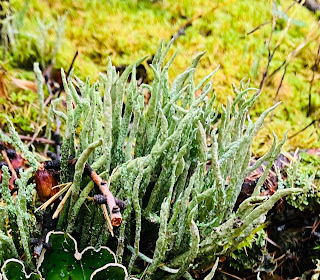 The weather changed dramatically overnight: The rain stopped by morning but was replaced by high winds coming from the bay at between 20 and 30 miles per hour. So even though the air temperature was not objectively that cold (low 40’s), it was just brutal on the flats by the bay. So our guides decided instead to take us on walks in the boreal forest and across the willow bogs. We went first for a short walk in the morning - about 1 hour, and then a much longer one in the afternoon - about 2 1/2 hours, probably 3.5 miles - which does not sound like much, but wait till you see some of the pictures of the bogs …..
The weather changed dramatically overnight: The rain stopped by morning but was replaced by high winds coming from the bay at between 20 and 30 miles per hour. So even though the air temperature was not objectively that cold (low 40’s), it was just brutal on the flats by the bay. So our guides decided instead to take us on walks in the boreal forest and across the willow bogs. We went first for a short walk in the morning - about 1 hour, and then a much longer one in the afternoon - about 2 1/2 hours, probably 3.5 miles - which does not sound like much, but wait till you see some of the pictures of the bogs …..The forest itself is a mixture of pines and deciduous trees, making for a wonderful array of colors. I particularly love the bright yellow of the poplar trees. We followed animal path, as well as natural ridges created by vestigial beaches (see previous post to learn more about isoplastic rising) .
It is interspersed with ponds, willow bogs, and rivers, making for at times challenging walking….. we were very grateful for the tall mud boots we were wearing!
 Along the forest floors was an amazing diversity of lichen, moss and mushrooms. I may have driven my hiking group a bit crazy by stopping to take a picture every time i saw a new type of lichen.
Along the forest floors was an amazing diversity of lichen, moss and mushrooms. I may have driven my hiking group a bit crazy by stopping to take a picture every time i saw a new type of lichen.Not everyone share my enthusiasm for the diversity of lichen. But they are wrong! Lichen are amazing!!!! Anyway, amongst many other types, here are Caribou lichen (so named because caribou have developed a special enzyme that makes it possible for them to digest it - no other creature can), specked, powder horn and soldier lichen- amongst many others! (See more pictures at the end end)

 There was also an huge variety of mushroom - tons of edible boletus (which is would have loved to harvest but didn’t because it’s probably illegal to bring them back to the US), but many, MANY other, which would be a lot of fun to identify…. No time for that however. I gave a quick tutorial to my fellow travelers about the difference between boletus and gilled mushrooms. It just seems a shame to have no one here harvest them, so maybe I inspired them.
There was also an huge variety of mushroom - tons of edible boletus (which is would have loved to harvest but didn’t because it’s probably illegal to bring them back to the US), but many, MANY other, which would be a lot of fun to identify…. No time for that however. I gave a quick tutorial to my fellow travelers about the difference between boletus and gilled mushrooms. It just seems a shame to have no one here harvest them, so maybe I inspired them.And here is a lichen grown on a very large mushroom!
Speaking of mushrooms: here an there, you see mushrooms in trees- not growing them, but having been put there by red squirrels for eating later -
I actually thought our guide was joking and maybe had put the mushrooms up himself. But I googled it and it’s a thing! Aint’s nature grand??
The thick moss was in places like a soft and plus carpet. This area has « intermittent permafrost » - which means that areas that are well protected may have permafrost underneath. The thick moss is a telltale sign.
We tracked moose- there were a lot of tracks and poop! But that are very shy and we did not find them.

Speaking of poop- we also saw a lot of black bear and wolf poop! And ptarmigan - but I forgot to take a picture- are’nt you disappointed ? ]
We had a nice drink (or two… or three) with a team, followed by a last very nice dinner.



















.JPG)

















No comments:
Post a Comment